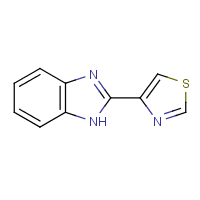Thiabendazole
Agent Name
Thiabendazole
CAS Number
148-79-8
Formula
C10-H7-N3-S
Major Category
Other Uses

Synonyms
1H-Benzimidazole, 2-(4-thiazolyl)-; 2-(1,3-Thiazol-4-yl)benzimidazole; 2-(4-Thiazolyl)-1H-benzimidazole; 2-(4-Thiazolyl)benzimidazole; 2-Thiazole-4-ylbenzimidazole; 4-(2-Benzimidazolyl)thiazole; APL-luster; Benzimidazole, 2-(4-thiazolyl)-; Biogard; Bioguard; Bovizole; Captan T; Chemviron TK 100; Cropasal; E-Z-Ex; Eprofil; Equizole; Equizole A; G 491; Helmindrax octelmin; Hokustar HP; Lombristop; MK 360; MK-360; Mertec; Mertect; Mertect 160; Metasol TK-100; Mintesol; Mintezol; Mintezole; Minzolum; Mycozol; Nemapan; Omnizole; Ormogal; Pitrizet; Polival; RPH; RTU Flowable Fungicide; Rival; Sanaizol 100; Sistesan; Storite; Syntol M100; TBZ; TBZ 60W; TBZ-6; Tbdz; Tebuzate; Tecto 10P; Tecto 40F; Tecto 60; Tecto RPH; Testo; Thiaben; Thiabendazol; Thiabendazole [BSI:ISO]; Thiabendazolum; Thiabenzole; Thibenzol; Thibenzole; Thibenzole 200; Thibenzole ATT; Tiabenda; Tiabendazol [INN-Spanish, French]; Tiabendazole; Tiabendazolum [INN-Latin]; Tobaz; Top form wormer; Triasox; [ChemIDplus]
Category
Animal Feed Additives
Description
Colorless, white, or tan odorless solid; [HSDB] Colorless solid; [EPA REDs] Off-white to yellow-tan solid; [CPSQ]
Sources/Uses
Used to treat roundworm infections in animals and humans; also added to animal feed; [Kanerva, p. 1839] Used as a paint biocide; [Adams, p. 475] Used as a fungicide for potatoes and citrus fruit, for treatment and prevention of Dutch elm disease in trees, and as a human anthelmintic and veterinary anthelmintic and fungicide; [Merck Index] Used as a fungicide for various fruits and vegetables, soybeans, and wheat (seed treatment and post-harvest dip or spray); Also used to preserve paints, carpet, adhesives, paper products, and textiles; [EPA REDs] Used as a wood preservative; [ExPub: CPSQ]
Comments
Allergic contact dermatitis (ACD) reported in feed mill workers; [Kanerva, p. 1839] Ingestion of high doses can cause hepatic injury. [Zimmerman, p. 412] Reports of liver injury, CNS effects, and hypersensitivity reactions (rashes, conjunctivitis, erythema multiforme, Stevens-Johnson syndrome, and angioedema) in patients; Report of ACD in banana plantation employees; [HSDB] The hypophosphite salt (CAS# 28558-32-9) is used in the non-food applications; Not irritating to skin or eyes and not a skin sensitizer; May interfere with thyroid-pituitary homeostasis; "Likely to be carcinogenic at doses high enough to cause disturbance of the thyroid hormone balance. It is not likely to be carcinogenic at doses lower than those which could cause a disturbance of this hormonal balance.” [EPA REDs]
Reference Link #1
Biomedical References
Exposure Assessment
MAK
20 mg/m3, inhalable fraction
Vapor Pressure
4E-09 mm Hg
Explanatory Notes
VP from HSDB;
Reference Link #2
Adverse Effects
Skin Sensitizer
Yes
Hepatotoxin
Hepatoxic (a) from occupational exposure (secondary effect) or (b) in animal studies or in humans after ingestion
Diseases, Processes, and Activities Linked to This Agent
Diseases
Occupational diseases associated with exposure to this agent:
Processes